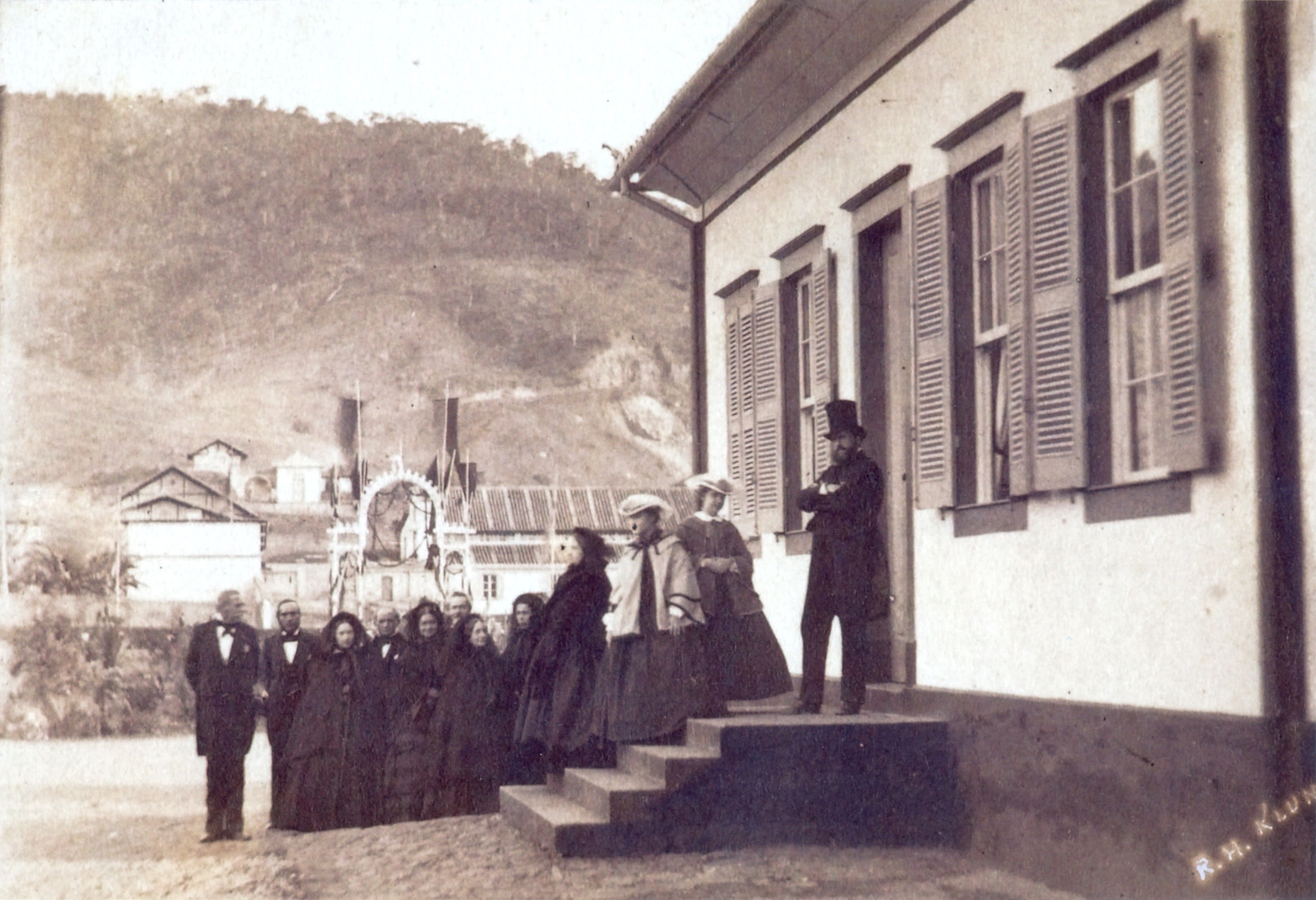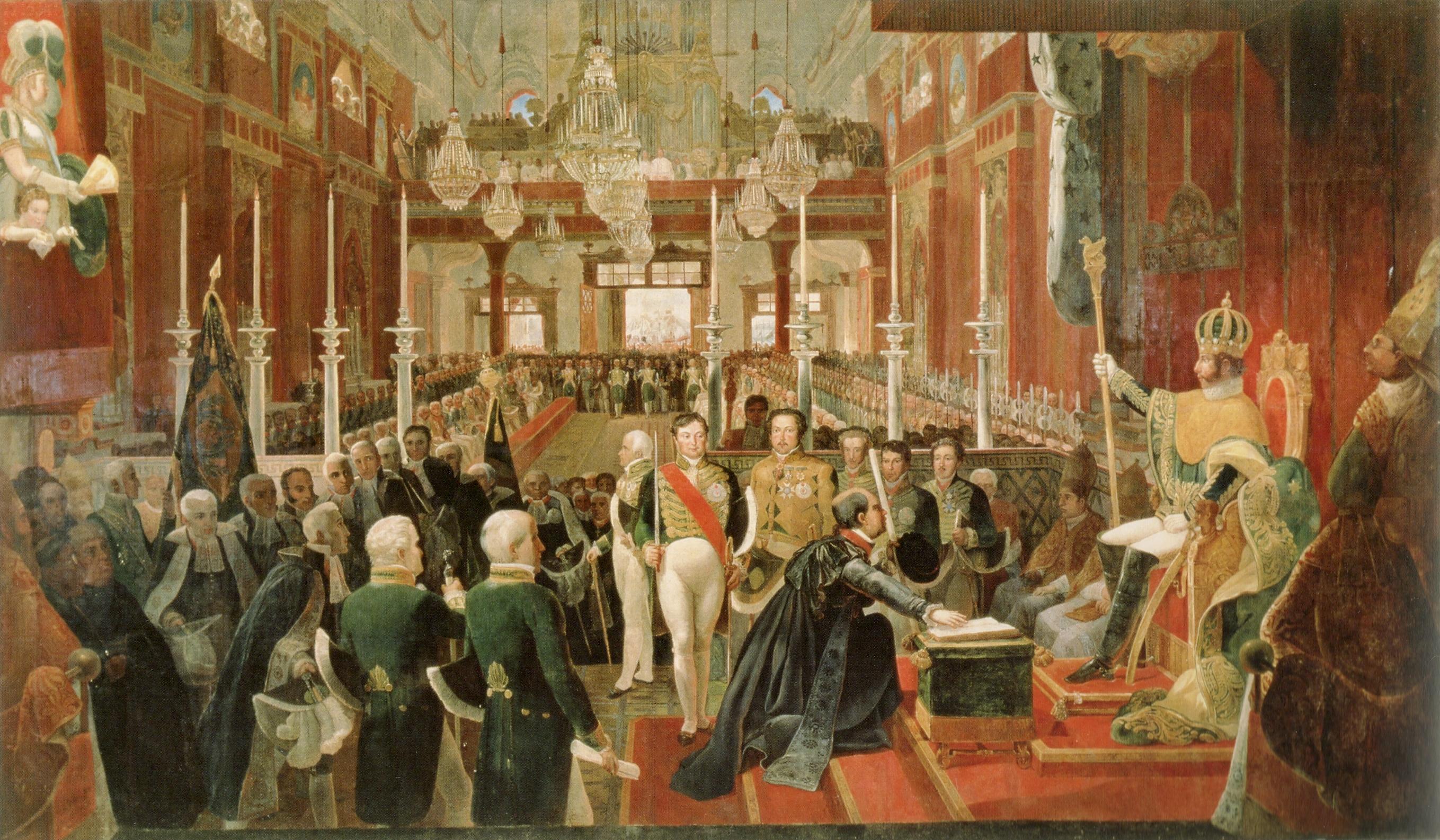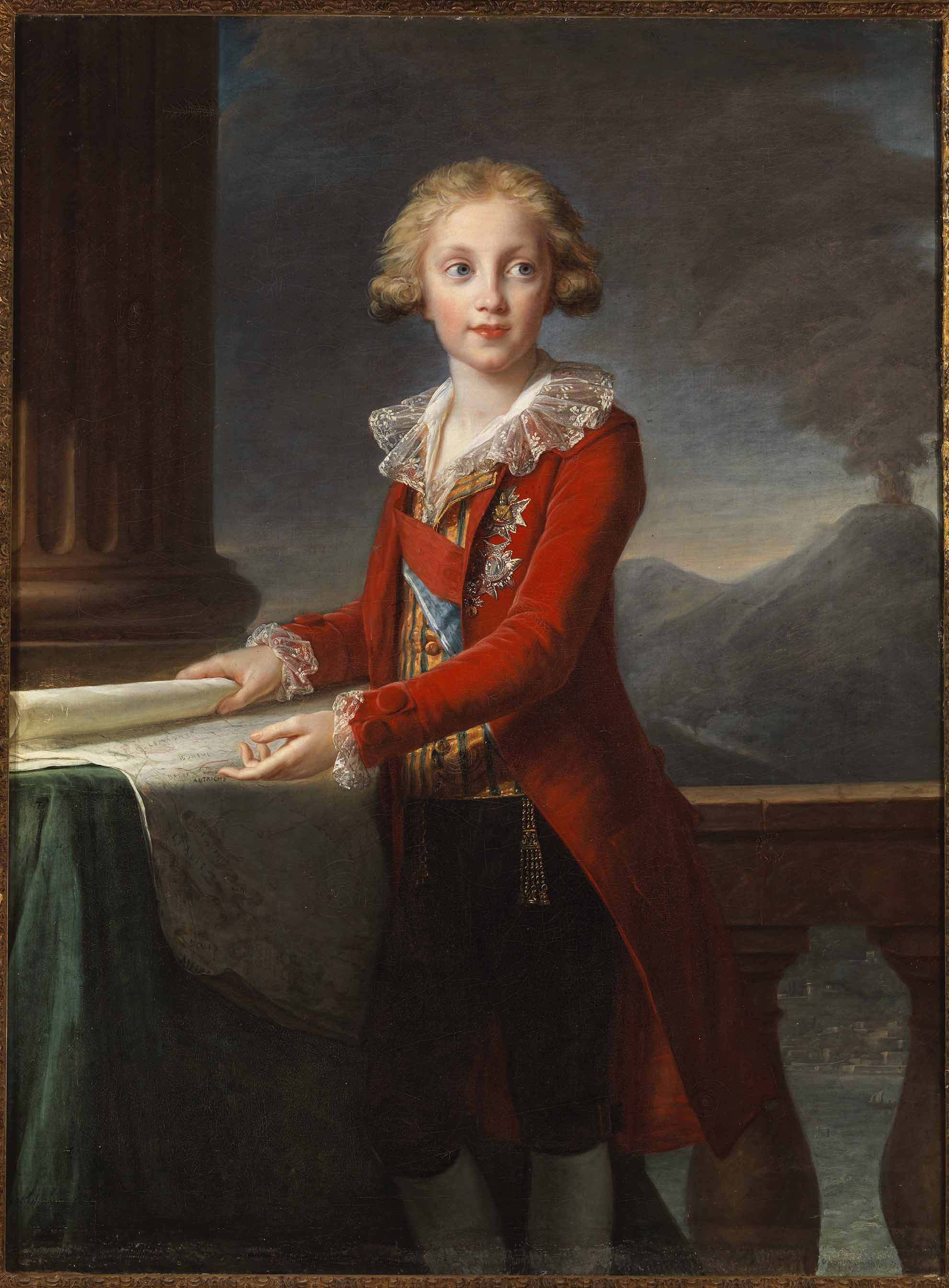|
Princess Leopoldina Of Brazil
Princess Leopoldina of Brazil (Leopoldina Teresa Francisca Carolina Miguela Gabriela Rafaela Gonzaga; 13 July 1847 – 7 February 1871) was the daughter of Emperor Pedro II and Empress Teresa Cristina. She shared the first name of her grandmother, Empress Maria Leopoldina of Brazil. A Princess of Brazil from birth, Dona Leopoldina renounced her titles upon her marriage to Prince Ludwig August of Saxe-Coburg and Gotha, taking the title of ''Princess of Saxe-Coburg and Gotha'' and ''Duchess of Saxony''. The princess was also second in the line of succession to the Brazilian throne, even after the marriage of her older sister, Isabel, Princess Imperial of Brazil, due to the latter's difficulties in producing heirs. Her descendants would form the Braganza-Saxe-Coburg and Gotha branch of the Imperial House of Brazil. Biography Family and early years Leopoldina was born at 6:45 am on July 13, 1847, in the Imperial Palace of São Cristóvão, the second daughter of Pedro II ... [...More Info...] [...Related Items...] OR: [Wikipedia] [Google] [Baidu] |
Brazilian Imperial Family
The Brazilian Imperial Family (Brazilian Portuguese: ''Família Imperial Brasileira'') is a Brazilian Dynasty of Portuguese origin that ruled the Empire of Brazil from 1822 to 1889, after the proclamation of independence by Prince Pedro of Braganza who was later acclaimed as Pedro I, ''Constitutional Emperor and Perpetual Defender of Brazil''. The members of the family are dynastic descendants of Emperor Pedro I. Claimants to headship of the post-monarchic Brazilian Imperial legacy descend from Emperor Pedro II, including the senior agnates of two branches of the House of Orléans-Braganza; the so-called ''Petrópolis'' and ''Vassouras'' lines. Prince Pedro Carlos of Orléans-Braganza (born 1945) heads the '' Petrópolis'' line, while the '' Vassouras'' branch is led by his second cousin, Bertrand of Orléans-Braganza.Les manuscrits du C.E.D.R.E. – Dictionnaire Historique et Généalogique, vol. III. ''Le Royaume de Portugal, L’Empire du Brésil''. Cercle d'Études des Dynast ... [...More Info...] [...Related Items...] OR: [Wikipedia] [Google] [Baidu] |
Paço De São Cristóvão
Paço de São Cristóvão (; en, Palace of Saint Christopher; also known as Palácio Imperial or Palácio Imperial de São Cristóvão) was an imperial palace located in the Quinta da Boa Vista park in the Imperial Neighbourhood of São Cristóvão, Rio de Janeiro, Brazil. It served as residence to the Portuguese Royal Family and later to the Brazilian Imperial Family until 1889, when the country became a republic through a coup d'état deposing Emperor Pedro II. The palace briefly served as a public building by the provisional government for the constituent assembly of the first republican constitution. It housed the major part (92.5%) of the collections of the National Museum of Brazil, which, together with the building, were largely destroyed by a fire on 2 September 2018. History Background In the 16th and 17th centuries, the area where the Palace is currently located, was part of a Jesuit farm in the outskirts of Rio de Janeiro. With the expulsion of the Order in 1759, t ... [...More Info...] [...Related Items...] OR: [Wikipedia] [Google] [Baidu] |
Dom (title)
Don (; ; pt, Dom, links=no ; all from Latin ', roughly 'Lord'), abbreviated as D., is an honorific prefix primarily used in Spain and Hispanic America, and with different connotations also in Italy, Portugal and its former colonies, and Croatia. ''Don'' is derived from the Latin ''dominus'': a master of a household, a title with background from the Roman Republic in classical antiquity. With the abbreviated form having emerged as such in the Middle Ages, traditionally it is reserved for Catholic clergy and nobles, in addition to certain educational authorities and persons of distinction. ''Dom'' is the variant used in Portuguese. The female equivalent is Doña (), Donna (), Doamnă (Romanian) and Dona () abbreviated D.ª, Da., or simply D. It is a common honorific reserved for women, especially mature women. In Portuguese "Dona" tends to be less restricted in use to women than "Dom" is to men. In Britain and Ireland, especially at Oxford, Cambridge, and Dublin, the wor ... [...More Info...] [...Related Items...] OR: [Wikipedia] [Google] [Baidu] |
Mariana Carlota De Verna Magalhães Coutinho
Mariana may refer to: Literature * ''Mariana'' (Dickens novel), a 1940 novel by Monica Dickens * ''Mariana'' (poem), a poem by Alfred Tennyson, 1st Baron Tennyson * ''Mariana'' (Vaz novel), a 1997 novel by Katherine Vaz Music *"Mariana", a song by Alberto Cortez *"Mariana", a song by Collectif Métissé *"Mariana", a song by Gibson Brothers Places *Mariana, Minas Gerais, Brazil **Roman Catholic Archdiocese of Mariana * Mariana Lake, Alberta, Canada *Mariana, Corsica **Roman Catholic Diocese of Mariana in Corsica * Mariana, Humacao, Puerto Rico, a barrio *Mariana, Naguabo, Puerto Rico, a barrio * Mariana, Spain * Mariana, Quezon City, a barangay in Metro Manila, the Philippines; better known as New Manila *Mariana Islands, a group of islands in the north-western Pacific Ocean *Mariana Trench, the deepest trench in the world's oceans *Terra Mariana, alternative name (sobriquet) of modern Estonia, a medieval HRE principality in Estonia and Latvia Zoology * ''Mariana'', a syn ... [...More Info...] [...Related Items...] OR: [Wikipedia] [Google] [Baidu] |
Louis Philippe I
Louis Philippe (6 October 1773 – 26 August 1850) was King of the French from 1830 to 1848, and the penultimate monarch of France. As Louis Philippe, Duke of Chartres, he distinguished himself commanding troops during the Revolutionary Wars and was promoted to lieutenant general by the age of nineteen, but he broke with the Republic over its decision to execute King Louis XVI. He fled to Switzerland in 1793 after being connected with a plot to restore France's monarchy. His father Louis Philippe II, Duke of Orléans (Philippe Égalité) fell under suspicion and was executed during the Reign of Terror. Louis Philippe remained in exile for 21 years until the Bourbon Restoration. He was proclaimed king in 1830 after his cousin Charles X was forced to abdicate by the July Revolution (and because of the Spanish renounciation). The reign of Louis Philippe is known as the July Monarchy and was dominated by wealthy industrialists and bankers. He followed conservative policies, e ... [...More Info...] [...Related Items...] OR: [Wikipedia] [Google] [Baidu] |
Envoy (title)
An envoy extraordinary and minister plenipotentiary, usually known as a minister, was a diplomatic head of mission who was ranked below ambassador. A diplomatic mission headed by an envoy was known as a legation rather than an embassy. Under the system of diplomatic ranks established by the Congress of Vienna (1815), an envoy was a diplomat of the second class who had plenipotentiary powers, i.e., full authority to represent the government. However, envoys did not serve as the personal representative of their country's head of state. Until the first decades of the 20th century, most diplomatic missions were legations headed by diplomats of the envoy rank. Ambassadors were only exchanged between great powers, close allies, and related monarchies. After World War II it was no longer considered acceptable to treat some nations as inferior to others, given the United Nations doctrine of equality of sovereign states. The rank of envoy gradually became obsolete as countries upgraded th ... [...More Info...] [...Related Items...] OR: [Wikipedia] [Google] [Baidu] |
Princess Francisca Of Brazil
Dona Francisca (2 August 1824 – 27 March 1898) was a princess of the Empire of Brazil (as daughter of Emperor Dom Pedro I, who also reigned as King Dom Pedro IV of Portugal, and his wife Maria Leopoldina of Habsburg), who became Princess of Joinville upon marrying François d’Orléans, son of the French king Louis Philippe I. The couple had three children. Through their oldest daughter, Francisca and François are the ancestors of Jean, Count of Paris, the present Orléanist pretender to the French throne. Biography Francisca was born on 2 August 1824 in the Palace of São Cristóvão, in Rio de Janeiro, capital of the Empire of Brazil. Her name in full was Francisca Carolina Joana Carlota Leopoldina Romana Xavier de Paula Micaela Gabriela Rafaela Gonzaga. Through her father, Emperor Dom Pedro I, she was a member of the Brazilian branch of the House of Braganza (Portuguese: ''Bragança'') and was referred to using the honorific " Dona" (Lady) from birth. ... [...More Info...] [...Related Items...] OR: [Wikipedia] [Google] [Baidu] |
François D'Orléans, Prince Of Joinville
François d'Orléans, Prince de Joinville (14 August 1818 – 16 June 1900) was the third son of Louis Philippe, King of the French, and his wife Maria Amalia of Naples and Sicily. An admiral of the French Navy, François was famous for bringing the remains of Napoleon from Saint Helena to France, as well as a talented artist, with 35 known watercolours. He married Princess Francisca of Brazil, daughter of Emperor Pedro I and sister of Emperor Pedro II. The dowry received by François upon the marriage became the Brazilian city of Joinville. François and Francisca's grandson Jean went on to become the Orléanist claimant to the extinct French throne, a claim passed on to his son, grandson and now great-grandson Jean, Count of Paris, current Orléanist claimant to the French crown. Early life and military career He was born François-Ferdinand-Philippe-Louis-Marie d'Orléans at the Château de Neuilly, in Neuilly-sur-Seine, France. Educated for the navy, he was commissi ... [...More Info...] [...Related Items...] OR: [Wikipedia] [Google] [Baidu] |
Old Cathedral Of Rio De Janeiro
The Old Cathedral of Rio de Janeiro dedicated to Our Lady of Mount Carmel (full name in ) is an old Carmelite church which served as cathedral (''Sé'') of Rio de Janeiro from around 1808 until 1976. During the 19th century, it was also used successively as Royal and Imperial Chapel by the Portuguese Royal Family and the Brazilian Imperial Family, respectively. It is located in the '' Praça XV'' square, in downtown Rio. It is one of the most important historical buildings in the city. History Carmelite Church in the Colonial era When the Carmelite Order arrived in Rio in 1590, they settled in a small chapel near Guanabara Bay. During the 17th and 18th centuries, the order built a large convent and renovated the chapel, referred to as the ''Igreja de Nossa Senhora do Monte do Carmo ''(Church of Our Lady of Mount Carmel). Building of the present church started around 1761, and was probably directed by Portuguese architect Manuel Alves Setúbal. The church was consecrated in 177 ... [...More Info...] [...Related Items...] OR: [Wikipedia] [Google] [Baidu] |
Princess Leopoldina 1853 (cropped)
Princess is a regal rank and the feminine equivalent of prince (from Latin ''princeps'', meaning principal citizen). Most often, the term has been used for the consort of a prince, or for the daughter of a king or prince. Princess as a substantive title Some princesses are reigning monarchs of principalities. There have been fewer instances of reigning princesses than reigning princes, as most principalities excluded women from inheriting the throne. Examples of princesses regnant have included Constance of Antioch, princess regnant of Antioch in the 12th century. Since the President of France, an office for which women are eligible, is ''ex-officio'' a Co-Prince of Andorra, then Andorra could theoretically be jointly ruled by a princess. Princess as a courtesy title Descendants of monarchs For many centuries, the title "princess" was not regularly used for a monarch's daughter, who, in English, might simply be called "Lady". Old English had no female equivalent of "prince ... [...More Info...] [...Related Items...] OR: [Wikipedia] [Google] [Baidu] |
María Isabella Of Spain
Maria Isabella of Spain (María Isabel de Borbón y Borbón-Parma; 6 July 1789 – 13 September 1848) was an infanta of Spain and queen consort of the Two Sicilies by marriage to Francis I of the Two Sicilies. Infanta of Spain She was the youngest daughter of King Carlos IV of Spain and his wife Maria Luisa of Parma. María Isabel's birth coincided with the rise to power in Spain of her mother's favorite, Manuel Godoy. Court rumour attributed María Isabel's paternity not to the king, but to the young Godoy, who became Spain's prime minister in 1792.Rubio, '' Reinas de España'', p. 307Rubio, '' Reinas de España'', p. 311 The Infanta's childhood coincided with the events of the French revolution and political turbulence in Spain.Rubio, '' Reinas de España'', p. 308 The youngest surviving daughter in a large family, María Isabel was spoilt by both of her parents and her education was rudimentary.Acton, ''The Bourbons of Naples'', pp. 3, 35, 132-134, 326, 366, 478-479, 679 ... [...More Info...] [...Related Items...] OR: [Wikipedia] [Google] [Baidu] |
Francis I Of The Two Sicilies
Francis I of the Two Sicilies ( it, Francesco Gennaro Giuseppe Saverio Giovanni Battista; 19 August 1777 – 8 November 1830) was King of the Two Sicilies from 1825 to 1830 and regent of the Kingdom of Sicily from 1806 to 1814. Biography Francis was born the son of Ferdinand I of the Two Sicilies and his wife Archduchess Maria Carolina of Austria in Naples. He was also the nephew of Marie Antoinette and Louis XVI, the last King and Queen of France before the first French Republic. At the death of his older brother Carlo, Duke of Calabria, Francis became the heir-apparent to the throne and ''Duke of Calabria'', the traditional title of the heir apparent to the Neapolitan throne. Later life In 1796 Francis married his double first cousin Archduchess Maria Clementina of Austria, daughter of Leopold II, Holy Roman Emperor. When she died, he married his first cousin María Isabella, daughter of King Charles IV of Spain. After the Bourbon family fled from Naples to Sicily in ... [...More Info...] [...Related Items...] OR: [Wikipedia] [Google] [Baidu] |
.jpg)







